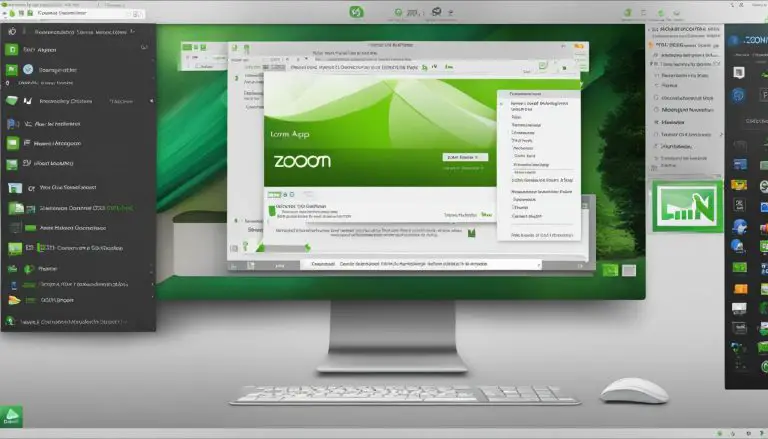Understanding Firewalls: What is Iptables Explained Simply
Welcome to the first section of our comprehensive guide on understanding firewalls and specifically, what is Iptables. In this article, we will explore the basics of Iptables, its definition, and how it works as a powerful firewall interface in the Linux operating system.
Iptables is a fundamental component in managing system ports and controlling network traffic. As the front end interface to the netfilter kernel module, it plays a crucial role in determining which packets are allowed to pass through the system. With its flexibility and packet manipulation options, Iptables provides a robust tool for configuring and securing your firewall.
So, let’s dive into the world of Iptables and unravel its functionality and significance in firewall management.
Key Takeaways:
- Iptables is a firewall interface in the Linux operating system that manages system ports and controls network traffic.
- It is the front end interface to the netfilter kernel module, responsible for determining which packets are allowed to pass through the system.
- Iptables offers a full-featured tool with flexibility and options for packet manipulation, making it a powerful tool for firewall configuration.
- Understanding Iptables is essential for effectively securing and managing your Linux system’s firewall.
- Stay tuned for the next sections where we delve deeper into the world of firewalls and explore other aspects of Iptables.
What is a Firewall and Why Use Iptables?
A firewall is a critical security measure that plays a vital role in protecting computer systems from unauthorized access and malicious activity. It acts as a barrier between your system and the outside world, filtering and controlling network traffic based on predefined rules. By using a firewall, you can safeguard your system from potential threats and vulnerabilities.
Iptables is a preferred choice for firewall configuration due to its robustness, flexibility, and advanced features. It is a firewall interface in the Linux operating system that manages system ports and controls the flow of network packets. With iptables, you can make informed decisions on which ports and protocols are allowed to communicate with the outside world, ensuring that only legitimate traffic reaches your system.
Iptables offers a comprehensive toolset for packet manipulation, enabling you to perform actions such as network address translation (NAT), logging, and forwarding. This level of control allows you to tailor your firewall configuration to meet your specific security requirements and effectively protect your system. Whether you are a beginner or an experienced user, understanding iptables basics is essential for creating a secure network environment.
Benefits of Using Iptables
- Flexibility: Iptables provides a wide range of options for configuring and customizing your firewall rules. You can define specific criteria for allowing or blocking traffic, such as IP addresses, ports, protocols, and packet attributes.
- Powerful Packet Manipulation: Iptables allows you to modify packet headers, change source/destination IP addresses, perform port forwarding, and apply network address translation (NAT). These features give you fine-grained control over network traffic.
- Logging and Monitoring: With iptables, you can enable logging to record information about packets that match specific rules. This enables you to monitor network activity, analyze traffic patterns, and troubleshoot any potential issues.
- Compatibility: Iptables is supported on most Linux distributions and is widely used in the industry. Its popularity ensures a wealth of online resources and community support, making it easier to find solutions and troubleshoot problems.
By understanding the basics of iptables and its benefits, you can leverage its power and flexibility to create a robust firewall configuration that protects your system from unauthorized access and malicious threats.
| Key Features | Benefits |
|---|---|
| Advanced packet filtering | Enhanced network security by controlling incoming and outgoing traffic |
| Network address translation (NAT) | Enables routing and translation of IP addresses, increasing network flexibility |
| Logging and monitoring capabilities | Provides visibility into network traffic, aiding in troubleshooting and detecting potential threats |
| Flexible rule configuration | Allows fine-grained control over network traffic based on various criteria |
| Compatibility with Linux distributions | Supported on most Linux systems, ensuring widespread adoption and community support |
How Iptables Works: Architecture and Components
Iptables is a powerful firewall interface that operates within the Linux operating system. It consists of several components that work together to filter and process network packets. Understanding the architecture and components of Iptables is crucial for effective firewall configuration and management.
Architecture
The architecture of Iptables is based on chains, tables, and targets, which collectively determine the fate of network packets. Chains are specific tasks that handle packets at different stages, such as when they arrive, when they are destined for the local system, when they need to be forwarded, or when they are leaving the system. The commonly used chains include prerouting, input, forward, output, and postrouting.
Tables
Tables in Iptables determine the type of processing applied to packets. There are several tables available, including:
- Filter: The default table for filtering packets.
- Nat: Used for network address translation (NAT) tasks, such as port forwarding.
- Mangle: Used for advanced packet alteration, such as modifying packet headers.
- Raw: Used for configuring exemptions from connection tracking.
- Security: Used for Mandatory Access Control (MAC) rules based on security labels.
Targets
Targets in Iptables determine the fate of packets that match specific rules. They define whether packets are allowed, rejected, or modified. Some commonly used targets include:
- ACCEPT: Allows packets to pass through.
- DROP: Drops packets without sending any response.
- REJECT: Drops packets and sends an error message back to the source.
- RETURN: Exits the current chain and resumes processing in the previous chain.
Iptables also supports various extensions that provide additional functionality and targets for specific purposes.
Understanding the architecture and components of Iptables is essential for configuring a secure and efficient firewall. By utilizing chains, tables, and targets effectively, system administrators can control network traffic and protect their systems from unauthorized access and malicious activity.
Getting Started with Iptables: Installation and Configuration
Configuring and managing iptables involves a few essential steps. Let’s begin with the installation process. Iptables is typically installed by default on most Linux systems. However, you may need to disable other firewall utilities like firewalld or ufw before enabling iptables. To install iptables, you can use package managers specific to your Linux distribution. For example, on Debian-based distributions, you can use the command apt-get install iptables, while on Red Hat-based distributions, you can use yum install iptables.
Once installed, you can configure iptables using command-line commands. These commands provide a flexible way to manage your firewall rules. Here are some common commands:
- iptables -L: This command lists the current configuration of your iptables rules.
- iptables -P: Use this command to set the default policy for your firewall chains.
- iptables -A: This command appends a rule to a specific chain.
- iptables -D: Use this command to delete a specific rule from a chain.
- iptables -I: This command inserts a rule at a specific position in a chain.
With these commands, you can stop all packet traffic, allow or deny packets on specific interfaces or ports, and configure rules for specific protocols or IP addresses. Remember to save your configuration after making changes to ensure they persist across system reboots. The iptables-save command saves the current configuration to a file, which can be loaded using the iptables-restore command on system startup.
Iptables Configuration Example
| Chain | Rule | Action |
|---|---|---|
| INPUT | -i eth0 | ACCEPT |
| OUTPUT | -o eth0 | ACCEPT |
| FORWARD | -j DROP |
The table above represents a simple example of iptables configuration rules. In this case, the INPUT chain allows incoming packets on the eth0 interface, the OUTPUT chain allows outgoing packets on the eth0 interface, and the FORWARD chain drops all forwarded packets.
By following these installation and configuration steps, you can begin to customize and secure your system’s network traffic using iptables. Remember to refer to the official documentation and consult with experts for advanced iptables configurations and optimizations.
Basic Iptables Commands: Filtering Traffic
When it comes to managing network traffic, Iptables offers a variety of powerful commands that allow you to filter and control the flow of packets. By using these commands, you can configure a basic firewall that suits your specific needs. Let’s take a look at some of the essential Iptables commands for filtering traffic:
Adding Rules
One of the primary ways to filter traffic with Iptables is by adding rules to the INPUT, OUTPUT, and FORWARD chains. These rules determine whether packets are allowed, dropped, or rejected based on specific criteria. For example, you can block incoming traffic from a specific IP address by using the DROP target or allow outgoing traffic to a specific port using the ACCEPT target. By carefully crafting these rules, you can create a robust firewall to protect your system.
Blocking IP Addresses or Ranges
One common use case for Iptables is blocking certain IP addresses or ranges from accessing your system. This can be achieved by using the -s flag followed by the IP address or range and the -j DROP target. For example, to block the IP address 192.168.1.100, you would use the following command:
iptables -A INPUT -s 192.168.1.100 -j DROP
This command adds a rule to the INPUT chain that drops any packets coming from the specified IP address. Similarly, you can block an entire IP range by specifying the range using the CIDR notation. For example, to block the range 192.168.1.0/24, you would use the following command:
iptables -A INPUT -s 192.168.1.0/24 -j DROP
By utilizing these commands, you can effectively control the flow of traffic and enhance the security of your system.
Advanced Iptables Functions: NAT, Logging, and Forwarding
In addition to basic filtering capabilities, Iptables offers advanced functions that enhance the firewall’s functionality and control over network traffic. These advanced features include Network Address Translation (NAT), logging, and forwarding.
Iptables NAT
Iptables supports Network Address Translation (NAT) which allows you to route packets to networks that cannot be directly accessed by changing the source and destination addresses of packets. NAT is commonly used in scenarios where a private network needs to communicate with the public internet. By translating the IP addresses of packets, NAT enables connectivity between private and public networks, ensuring secure and efficient data transfer.
Iptables provides several options for configuring NAT, including source NAT (SNAT) and destination NAT (DNAT). SNAT modifies the source IP address of outgoing packets, while DNAT modifies the destination IP address of incoming packets. This flexibility allows you to customize the NAT rules to suit your specific networking needs.
Iptables Logging
Iptables supports logging, which enables the recording of information about packets that match specific rules. Logging can be a valuable tool for monitoring and troubleshooting network traffic. By configuring logging rules in Iptables, you can capture details such as source and destination IP addresses, packet sizes, protocols, and timestamps.
Logging is particularly useful for analyzing network activity, identifying potential security threats, and gaining insights into network performance. By reviewing the logged information, you can detect abnormal activity, track network usage patterns, and pinpoint any issues that may impact the performance or security of your system.
Iptables Forwarding
Iptables also provides forwarding capabilities, allowing your system to act as a router and forward packets between different networks. Forwarding rules enable you to define specific routes for packets, ensuring that they are correctly routed to their intended destinations.
By configuring forwarding rules in Iptables, you can establish complex network topologies and connect multiple networks together. This enables efficient communication between different segments of your network infrastructure, enhancing network connectivity and facilitating the flow of data.

Next Steps
The advanced functions of NAT, logging, and forwarding in Iptables provide powerful tools for managing and controlling network traffic. By leveraging these capabilities, you can optimize your firewall configuration to meet the specific requirements of your network infrastructure.
In the next section, we will explore the process of saving and managing Iptables rules, ensuring the persistence and proper management of your firewall configuration.
Saving and Managing Iptables Rules
Managing iptables rules is essential to ensure the effectiveness and security of your firewall configuration. Once you have configured iptables to filter and control network traffic, it is important to save the rules so that they persist after a system restart. To save the current iptables configuration, you can use the iptables-save command, which saves the rules to a file. This file can then be loaded using the iptables-restore command during system startup to restore the rules.
Aside from saving rules, you can also manage iptables rules by modifying or deleting specific rules. The iptables-delete command allows you to remove individual rules, while the iptables-flush command clears all rules from a chain. These management commands provide flexibility in configuring and maintaining your iptables rules.
It is good practice to regularly review and update your iptables rules to ensure they align with your current security requirements. By regularly reviewing and modifying rules as needed, you can adapt to changing network environments and minimize security risks. Additionally, documenting your iptables configuration and keeping backups of your rules can help in troubleshooting and restoring configurations if any issues arise.
| Command | Description |
|---|---|
| iptables-save | Saves the current iptables rules to a file |
| iptables-restore | Loads iptables rules from a file during system startup |
| iptables-delete | Removes specific iptables rules |
| iptables-flush | Clears all rules from a chain |
By following best practices in managing your iptables rules, you can ensure a well-configured and secure firewall that effectively protects your system from unauthorized access and malicious activity.
Using Iptables with IPv6
As a powerful firewall interface, Iptables provides the capability to configure and manage network traffic on Linux systems. While Iptables is widely known for its support of the IPv4 protocol, it also offers support for the newer IPv6 protocol. This allows users to apply firewall rules specifically designed for IPv6 traffic, ensuring comprehensive protection for their systems.
When configuring Iptables for IPv6, it is important to note that the syntax and commands differ from those used for IPv4. Users need to use the “ip6tables” command instead of “iptables” to manipulate IPv6 rules. However, the concepts and functionality remain similar, enabling users to apply a wide range of rules, filters, and actions to control and secure IPv6 traffic.
To configure Iptables for IPv6, users can utilize the same commands and techniques discussed earlier in this article. This includes setting up rules to allow or block specific IP ranges, ports, and protocols. Additionally, advanced features such as Network Address Translation (NAT), logging, and packet forwarding are also available for IPv6 traffic. By leveraging these capabilities, users can create a robust firewall configuration for both IPv4 and IPv6 protocols.
Benefits of Using Iptables with IPv6
By utilizing Iptables with IPv6, users can take advantage of the following benefits:
- Enhanced Security: Applying firewall rules to both IPv4 and IPv6 traffic ensures comprehensive protection for systems, minimizing the risk of unauthorized access or malicious activity.
- Consistent Management: Using Iptables for both IP protocols allows for consistent configuration and management of firewall rules, simplifying administrative tasks and reducing complexity.
- Future-Proofing: As IPv6 continues to gain prominence and adoption, having a firewall solution that supports IPv6 ensures compatibility and readiness for future network environments.
Overall, Iptables provides a powerful and versatile solution for managing network traffic and enforcing security measures. By utilizing Iptables with IPv6, users can harness the full potential of this firewall interface to protect their systems and networks.
| Feature | IPv4 | IPv6 |
|---|---|---|
| Addressing | 32-bit | 128-bit |
| Header Size | 20 bytes | 40 bytes |
| NAT Support | Yes | Yes |
| Available Address Space | 4.3 billion | 340 undecillion |
Alternatives to Iptables: Firewalld and UFW
While iptables is a powerful and widely used firewall solution, there are alternative tools available for managing firewalls on Linux systems. Two popular alternatives are Firewalld and UFW (Uncomplicated Firewall).
Firewalld:
Firewalld is a dynamic firewall management tool that provides a high-level interface for configuring and managing firewall rules. It simplifies the process of creating and managing rules by using zones and services. With Firewalld, you can easily define rules based on predefined services or applications, making it more beginner-friendly compared to iptables. It also supports both IPv4 and IPv6, allowing for comprehensive firewall configuration. Firewalld uses NetworkManager to control network zones and firewall settings, providing a seamless integration with the Linux networking stack.
UFW:
UFW, or Uncomplicated Firewall, is another user-friendly firewall configuration tool for Linux systems. It offers a simplified command-line interface, making it easy to configure and manage firewall rules. UFW is designed to be straightforward, with a focus on simplicity over advanced features. It uses simple syntax and provides basic functionality for creating rules to allow or deny specific ports or applications. UFW is a great choice for beginners or users who prefer a more intuitive and easy-to-use firewall solution.
Both Firewalld and UFW offer alternatives to the more complex and powerful iptables. Depending on your needs and level of expertise, either of these tools can provide an effective firewall solution for your Linux system.
Best Practices for Iptables Configuration
When it comes to configuring iptables, following best practices is essential to ensure the effectiveness and security of your firewall. By implementing these best practices, you can enhance the protection of your system and optimize the management of network traffic.
Here are some key best practices for iptables configuration:
- 1. Only allow necessary ports and protocols: Restricting access to only the ports and protocols required by your system minimizes the attack surface and reduces the risk of unauthorized access.
- 2. Use whitelisting instead of blacklisting: Rather than trying to block all potential threats, adopt a whitelist approach by explicitly allowing trusted sources and denying everything else. This approach provides a more secure firewall configuration.
- 3. Regularly review and update rules: Network environments are dynamic, so it’s important to review and update your iptables rules periodically. This ensures that your firewall remains aligned with your system’s requirements and evolving security needs.
- 4. Log network traffic: Enabling logging in iptables allows you to monitor and analyze network traffic, providing valuable insights into potential security incidents and aiding in troubleshooting.
- 5. Test and validate firewall rules: Before deploying iptables rules in a production environment, thoroughly test and validate them in a controlled setting. This helps identify any misconfigurations or unintended consequences that could impact network operations.
By adhering to these best practices, you can ensure that your iptables configuration is well-optimized, secure, and aligned with your system’s requirements. It is important to have a backup of your iptables rules and to document your configuration for future reference.
Example Table: A Comparison of Iptables Best Practices
| Best Practice | Description | Benefits |
|---|---|---|
| Only allow necessary ports and protocols | Restrict access to required ports and protocols | – Minimizes attack surface – Reduces risk of unauthorized access |
| Use whitelisting instead of blacklisting | Explicitly allow trusted sources, deny everything else | – Provides a more secure configuration – Blocks potential threats |
| Regularly review and update rules | Periodically review and update iptables rules | – Ensures alignment with evolving security needs – Maintains an optimized configuration |
| Log network traffic | Enable logging to monitor and analyze traffic | – Provides insights into potential security incidents – Aids in troubleshooting |
| Test and validate firewall rules | Thoroughly test and validate rules before deployment | – Identifies misconfigurations and unintended consequences – Ensures smooth network operations |
Implementing these best practices will help you establish a well-configured and secure firewall using iptables. Remember to regularly review and update your configuration to adapt to changing requirements and evolving security threats. By following these guidelines, you can leverage the full potential of iptables in protecting your system and network.
Troubleshooting Iptables Issues
Troubleshooting iptables issues can sometimes be a complex task, but with the right approach, it can be resolved effectively. When encountering problems, it’s important to analyze logs and check the syntax of your rules to identify any potential errors. Understanding the order of rules is also crucial, as iptables processes packets sequentially based on the first matching rule.
To start troubleshooting, you can review the iptables configuration files to ensure they are correctly set up. It’s also essential to check for any conflicts with other firewall solutions that may be running on your system. Sometimes, multiple firewalls can interfere with each other and cause unexpected behavior.
Another aspect to consider is verifying whether the necessary kernel modules are loaded. Iptables relies on netfilter modules to function correctly, and if they’re not loaded, it can result in issues. You can check the status of these modules using the appropriate command for your Linux distribution.
| Error | Possible Cause | Solution |
|---|---|---|
| iptables: No chain/target/match by that name. | The specified chain, target, or match does not exist. | Check the spelling and syntax of your rule. Ensure that the chain, target, or match exists or create it if necessary. |
| iptables: Operation not supported. | The operation is not supported by the kernel or the necessary modules are not loaded. | Check if your kernel supports the operation or if the required modules are loaded. Update your kernel or load the necessary modules if needed. |
| iptables: Unknown error. | An unknown error occurred. | Check the system logs for more information about the error. It could be due to a system-level issue or misconfiguration. |
“Iptables troubleshooting requires a systematic approach and a solid understanding of iptables-specific concepts. By reviewing the configuration, checking for conflicts, verifying kernel modules, and analyzing error messages, you can effectively identify and resolve iptables issues.”
Testing your rules with different packet scenarios can also help pinpoint the source of the problem. By simulating various network traffic patterns, you can determine if your rules are correctly matching the desired packets. Additionally, referring to official documentation, online forums, and community resources can provide valuable insights and solutions to common iptables issues.
Remember that iptables is a powerful tool, and misconfigurations can have unintended consequences. It’s always a good practice to have a backup of your iptables rules and document your configuration for future reference. This ensures that you can easily revert to a known working state if issues arise during troubleshooting.
Conclusion
In conclusion, iptables is an essential tool for managing and securing network traffic on Linux systems. With its flexible configuration options and powerful features, iptables allows for fine-grained control over firewall rules. By understanding the architecture, components, and functionality of iptables, users can effectively filter and regulate network traffic, protecting their systems from unauthorized access and malicious activities.
Whether you are a beginner or an experienced user, iptables offers the necessary capabilities to configure a robust firewall. Its support for both IPv4 and IPv6 protocols ensures compatibility and adaptability in diverse network environments. With iptables, you can implement advanced functions like NAT, logging, and forwarding, enhancing the functionality and security of your system.
Following best practices, such as regularly reviewing and updating rules, logging network traffic, and testing your firewall configuration, can help to maintain an effective and secure iptables setup. Troubleshooting iptables issues can be approached systematically by analyzing logs, checking rule syntax, and understanding the order of rules.
In summary, iptables remains a preferred choice for firewall configuration on Linux systems due to its extensive capabilities, flexibility, and support. By harnessing the power of iptables, users can protect their systems and ensure the secure transfer of network packets.
FAQ
What is Iptables?
Iptables is a firewall interface in the Linux operating system that manages system ports and controls network traffic.
What is a firewall and why use Iptables?
A firewall is a security measure that filters and regulates network traffic to protect a system from unauthorized access or malicious activity. Iptables is preferred because it offers more flexibility and features than simpler firewall solutions.
How does Iptables work?
Iptables works by using chains, tables, and targets to filter and process packets, making decisions on whether to allow, drop, or modify packets based on specific criteria.
How do I install and configure Iptables?
To install Iptables, you need to disable other firewall utilities and enable Iptables. You can then use package managers specific to your Linux distribution to install and configure Iptables using command-line commands.
What are some basic Iptables commands for filtering traffic?
Basic Iptables commands include adding rules to the INPUT, OUTPUT, and FORWARD chains to allow, drop, or reject packets based on specific criteria such as IP addresses, protocols, and ports.
What are the advanced functions of Iptables?
Iptables provides advanced functions such as network address translation (NAT), logging, and forwarding, allowing for more complex manipulation and management of network traffic.
How can I save and manage my Iptables rules?
You can save your Iptables rules using the iptables-save command and restore them using the iptables-restore command. You can also manage your rules by deleting specific rules or flushing all rules in a chain.
Can I use Iptables with IPv6?
Yes, Iptables supports both IPv4 and IPv6 protocols, but you need to use the ip6tables command for configuring Iptables with IPv6.
What are the alternatives to Iptables?
Firewalld and UFW are alternative firewall configuration tools that provide simpler interfaces for managing firewall rules.
What are some best practices for configuring Iptables?
Best practices include allowing only necessary ports and protocols, using whitelisting instead of blacklisting, regularly reviewing and updating rules, logging network traffic, and testing and validating rules.
How can I troubleshoot Iptables issues?
Troubleshooting Iptables issues involves analyzing logs, checking rule syntax, understanding rule order, reviewing configuration files, checking for conflicts with other firewalls, verifying loaded kernel modules, and testing rules with different packet scenarios.
- About the Author
- Latest Posts
Janina is a technical editor at Text-Center.com and loves to write about computer technology and latest trends in information technology. She also works for Biteno.com.






